
Moon and Planets
This actually started off as
a page on our company's intra-web (PDO, or Petroleum
Development Oman LLC), before my retirement, trying to find anybody with
experience in astro-photography... I have since added more images to it as I
tried out different cameras. Share my struggles trying to
photograph the bright stuff (Moon and planets).
Hi PDO Astronerds!
Would like to exchange experiences with any of you who have treaded this path before. If you have, please give me a call. Here are some of my puny attempts with an 8" Celestron Ultima 2000 SCT and Fuji 800 colour print film, taken at home in Ras al Hamra. Photos below simply scanned from prints made by Photocenter at CCC. Not exactly hi-tec. I found that my main headache was mirror flap when using a Canon EOS 600 camera; lost my entire first roll of film through camera shake. Switched to a different camera (an old, cheap Konica SLR). Anyone had better success with Canon EOS's? The EOS 600 does not have a mirror pre-release. Neither does the Konica, but it's much more compact and lighter.
Moon taken at prime focus (f/10, focal length 2030 mm)
:

Photos below taken using eyepiece projection (7mm Nagler). @ f/121, equivalent focal length 24100 mm!). Camera shake becomes serious business! In fact I could not use the camera shutter at all and had to resort to "hat trick" method. I found that this magnification has reached both the resolution limit of my scope and is at the seeing limit for most nights at Ras al Hamra. Simply too much shimmer. Shimmer can be clearly seen on video shots I made. Still waiting for that clear, still night! Since exposure using a hat (actually I was using a tray) can't be much shorter than a second or so, seeing conditions become very critical.
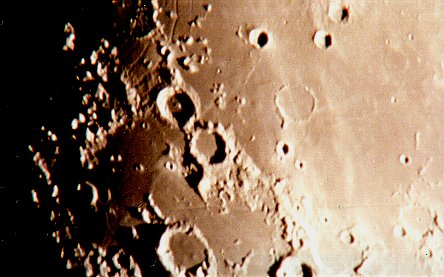
To appreciate the magnification, see if you can identify the region below on the earlier large photo. It's near the South Pole of the Moon.
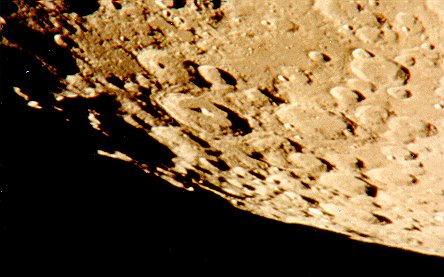
The picture below is the same as the previous image above, but rotated so that mountains are right-side up, as we are normally used to. Notice the strange psychology of upside-down mountains in the previous image. Now you know why Australians talk differently!
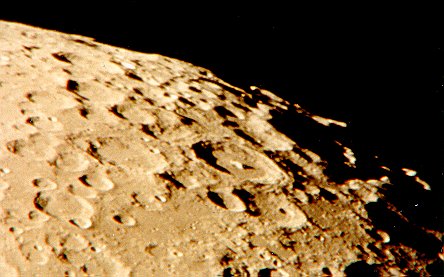
Jupiter with its 4 Galilean moons visible, taken at f/33 (equivalent focal length of 6500 mm):
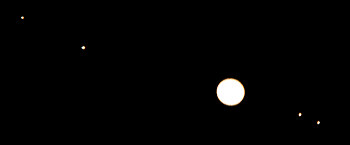
Jupiter taken at f/121 (equivalent focal length of 24100 mm):

Saturn taken at f/121 (equivalent focal length of 24100 mm):

Notice you can just about make out the Cassini Division splitting the rings. While one can see it fairly clearly visually though the scope, with all the atmospheric shimmer and the 2 second exposure required, it's tough to capture it sharply on film. Again, also at the resolution limit of my scope (diffraction limit for an 8" SCT is around 0.7 arc-second, for average seeing conditions atmospheric seeing/shimmer is supposed to be limited to about one arc-second). Anybody had success with using a video camera? I tried it out but it's rather difficult to hold the thing and image steady. Another headache I had was to get prints of the right density from the chap at Photocenter. Only way was to ask him to print each photo at 4 densities and choose the best.
Post-script added August 1999: I have since bought a second Canon EOS (with mirror pre-release this time!), EOS 50E, and tried it out on Venus and Mars. Waste of time, film and money. Moral of the story: for planet photos or high magnification Lunar photos do not even bother trying to use the shutter. Use the hat-trick method from the start. I have also found out that Mars is an excruciatingly frustrating planet to photograph, particularly during our Oman summer. You can see some detail on its surface, like "continents", but the disc is so tiny (this year's largest view was about 16 arc-seconds on 1st May 1999 when Mars was 87 million km from us) and the air at ground level at Ras al Hamra so unsteady, that one really needs very short exposures (video camera or fast CCD) to capture good images. Even with Fuji 800 colour negative film the exposure still needs to be almost a second long, thus atmospheric shimmer gets in the way. The summer heat haze, heavy with moisture and sand/dust, does not help either. This is the best I could get in May 1999 when the Mars disc was 15 to 16 arc-seconds in diameter:
Mars taken on 5th May 1999 at 1754 UT (or 2154 Oman Time):

Mars taken on 7th May 1999 at 1653 UT (or 2053 Oman Time):

I believe that the whitish patch towards bottom left is called Hellas and the darkish patch sticking upwards is Syrtis Major. You can see why in the olden days (until space probes were sent in the 1970s onwards) astronomers imagined seas, continents and, letting imagination run wild, even canals. In actual fact, as seen by the NASA Mars orbiters and landers, etc. it's all barren ground with varying colouration and continuously changing clouds/sandstorms. Notice that the planet has rotated quite a bit between the two photos. It so happens that the rates of rotation of the Earth and Mars are very similar (24 and 24.6 hours) and so, even though the photos are 47 hours apart, the rotation of the face seen is small; Mars had in the meantime also gone through two days and nights of its own.
Venus taken on 7th May 1999 at 1612 UT (or 2012 Oman Time)
![]()
You can see Venus like a quarter moon, actually a rather fuzzy mess! The Sun is illuminating it from below the horizon. Main problem is that our summer weather is so muggy and Venus was somewhat low in the sky at the time. Consequently the view was never sharp and even had colour fringes. I got rid of the colour fringes by showing you only the grey-scale image above :-)
In actual fact Venus was supposed to get larger (i.e. closer to Earth) and become a thinner crescent as summer progressed, but it was simply too hot, muggy and humid to take more photos.
In November 1999 I tried out a newly acquired CCD (SBIG/Celestron PixCel 237) to image Jupiter and Saturn. Below are RGB 3-colour combinations of Jupiter and Saturn taken at f20. The RGB filters do cut down the speed of the CCD tremendously, thus leading to seeing problems (atmospheric shimmer). In addition, it's also more difficult to have 3 good images rather than a single white light image. Nevertheless, I think they do look better than the film-based photographs above:
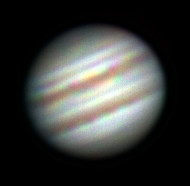
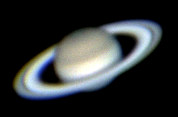
Below are side-by-side comparisons of the best that I could do with film in a Canon EOS 50E, the SBIG 237 astro CCD (640x480 pixels + an RGB filter wheel), and then a digital Canon EOS D30 (2160x1440 pixels with a built-in Bayer filter array):
|
|
|
|
|
Fujicolor 800 |
SBIG 237 |
D30 @ ISO 1600 |
|
|
|
|
Next below, Uranus by D30. Another gas giant, but awfully far. Hence dim, Magnitude 5.8, and a tiny 3.6 arc-seconds angular diameter. Compare to the above D30 Saturn and Jupiter, shot at the same magnification. And indeed, it is a turquoise blue.
![]()
Nice thing about the SBIG astro CCD is that it does not use a mechanical shutter, so there is no source of camera shake. Bad thing is that to get a colour photo you need to have at least 3 decent images, each through a different RGB filter. And then you have to worry about what ratios to use for R:G:B compositing to get the planet colour as the eye would see it if we could get that close. The middle monochromatic Saturn above is somewhat sharper than the best RGB of it that I managed to composite from the SBIG 237. But the consumer digital still camera, the Canon EOS D30, seems to be the answer for Lunar and planet photos. With mirror pre-release, the residual shake due to the shutter alone seems to be very little and the photos come out with the correct colour balance without any RGB compositing. Above rightmost photos were taken with the white balance of the D30 set to "Daylight", no fiddling required. Below see a comparison of a May 1999 Mars Fuji 800 image and a May 2001 D30 image, the latter a composite of 8, to bring out detail:
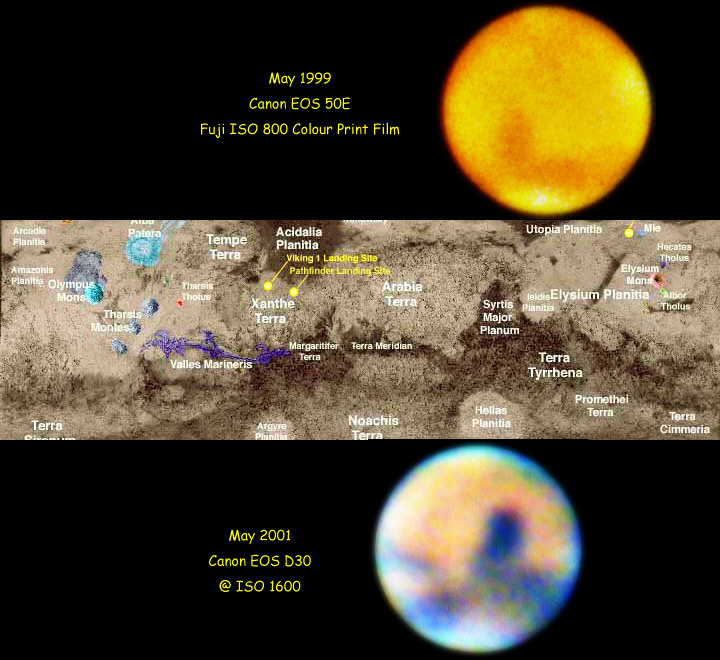
The photos were taken with eyepiece projection (effective focal length 24100mm) and my Celestron Ultima 2000 8" SCT but even then the image of the planet on the negative is less than 2 mm in diameter. The whole planet was 18 arc-sec in diameter for the D30 and around 16 for the film image.As a point of reference, the narrow neck of Terra Meridian (on the Syrtis Major side) in the Nasa map is roughly one arc-sec wide, so, bearing in mind the very poor seeing/haze/dust/mugginess of our summer weather, and the 0.7 arc-sec diffraction limit of the scope, the D30 looks quite promising as a lunar/planetary camera. And a lot more convenient than the SBIG 237 with its sequential RGB filters! The latter is still a contender for monochromatic images of the Moon and planets though. That non-mechanical shutter is really attractive at high magnifications. Here is the crater Clavius taken through the 8" SCT on film (at f121) and by the SBIG 237 CCD (at f6.3):
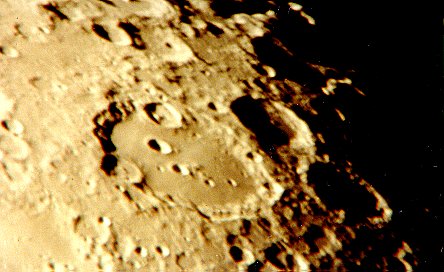
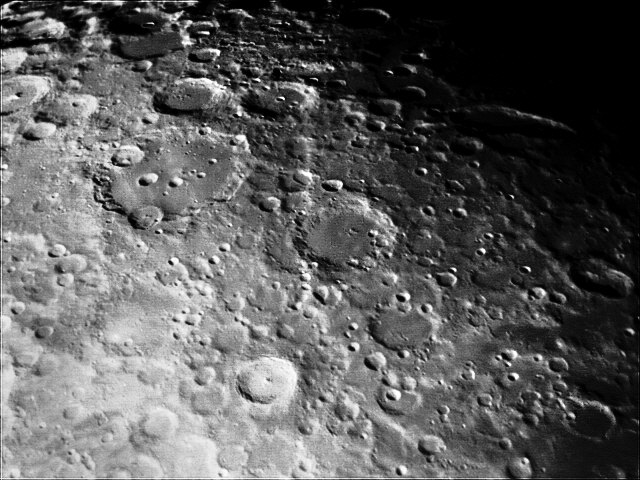
In conclusion, film is certainly the hard way of taking photos of the Moon and planets, but the cheapest. Go digital; and for colour images of such bright objects the Canon EOS D30 looks like a winner. The astro CCDs, like the SBIG 237, of course remain as yet unbeatable for faint objects such as galaxies and nebulae, despite having to use those confounded RGB filters sequentially.
Update in July 2003: I have just acquired a Philips ToUcam Pro webcam in an attempt to make life a bit easier for planetary photography. The attraction is that it is cheap, at around $100, it does not use a mechanical shutter, and it can take hundreds of colour images per minute. It is possible to purchase a plastic adapter for it (or make one) that replaces its tiny lens. You then simply swap out your scope's eyepiece and you are ready to go. The main disadvantage is that you need it to be connected to a PC. Focusing it is very easy compared to other cameras, since you have a live view, on screen. In fact I would say that the on-screen view, once you have adjusted stuff like exposure, contrast and brightness shows even more detail than looking through a 300x eyepiece. As stated above, film is hellishly difficult to use for planetary photography and the results obtainable by a digital SLR are far superior to what's possible with film. But the results with a $100 webcam are better, and far, far easier to acquire than with the digital SLR. Here's a comparison of the best Mars images I obtained with the Canon EOS D30 back in 2001 and what I got with the ToUcam Pro on my very first night up on the roof with it, south is up:
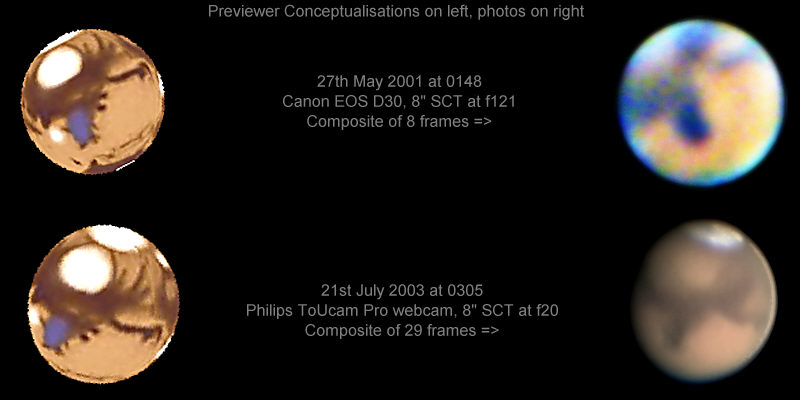
Mars' diameter was 18.5 arc-seconds in the 2001 photo and 20.3 arc-seconds in the 2003 photo, and the images have been scaled accordingly.
And so we arrive at an intellectual quandary: at what size should we display planetary images on the web? The images are often taken with vastly different telescopes, at very different focal ratios, yet each is always limited by the seeing conditions, the quality of the optics or the diffraction limit of the aperture used. Since the last is easily calculated, it is perhaps the best parameter on which to base the size of a posted image. E.g. The FWHM (Full Width at Half Max) of the diffraction disc at the wavelength where the eye is most sensitive (555nm) is 0.57arc-seconds for a C8 and 0.33arc-seconds for a C14 (Rayleigh criteria are 0.68 and 0.39arc-seconds respectively). Consequently if we resize to two pixels on the monitor for the diffraction-limited FWHM (as per Nyquist) we would be presenting all the details that can possibly have been recorded using a perfect scope of that aperture, without excessive bloat (i.e. avoiding empty magnification). The Hubble Space Telescope image below is presented as what a perfect 8" aperture might record were it launched into space. Compare it to my best C8 image to date:

and below is my best-to-date Mars captured by the ToUcam and a C14, on 22nd November 2005 at 1828UTC, also displayed at 2 monitor-pixels per theoretical, diffraction-limited FWHM:
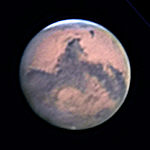
Larger scope, larger image. Earlier when I tried to capture the other side of Mars, the seeing was not as cooperative:
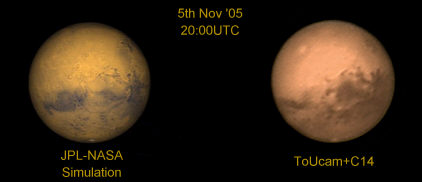
Note how much the South Polar Cap has shrunk between the 2003 opposition and the 2005. Below are my best-to-date images of Jupiter and Saturn, taken by the Philips ToUcam, of course, but not resized to the above criteria:
Jupiter through a C14 on 2nd March 2004: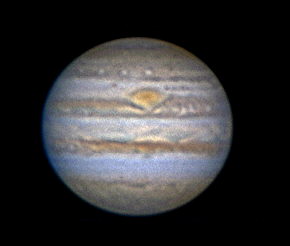
Saturn through a C14 on 9th January 2005: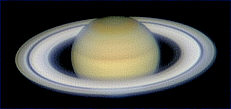
I hope you enjoyed sharing my above journey, from the excitement of first capturing the Cassini Division on Saturn, on film, steadily improving to being uppity and now claiming the elusive Encke Gap (that ultra-thin division very close to the edge of the rings, just about visible on the left side and a hint on the right side). Not convinced? OK, I have a larger version, together with a simulated view from JPL to point things out, here.
For more stuff return to Samir's Home
To drop me an e-mail just
click on:
samirkharusi